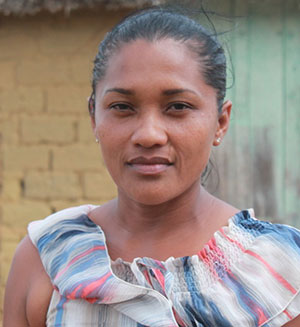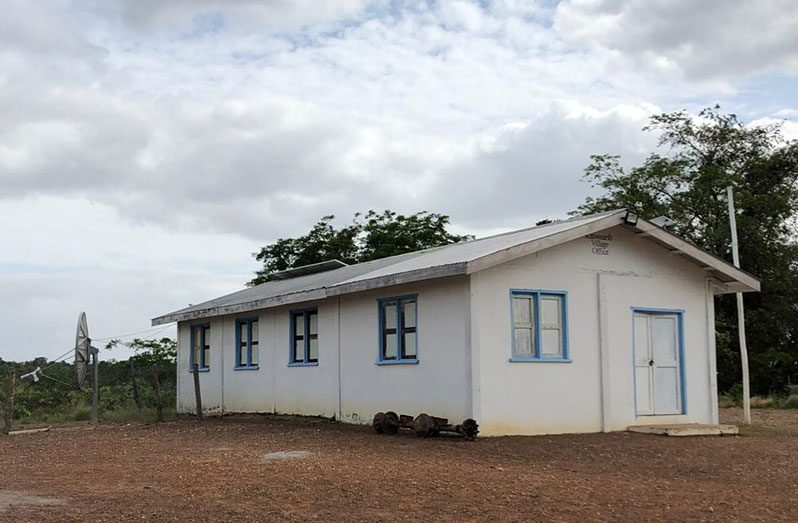WITH aftershocks continuing in the South Rupununi area, in Region Nine, (Upper Essequibo-Upper Takutu) since the January 31 earthquake that struck Guyana, the village of Katoonarib has had to contend with an internet ‘blackout’ following the disconnection of the government WiFi, caused by the tremors.
Last week, when the Sunday Chronicle visited the community, Deputy Toshao of Katoonarib, Floria Singh, highlighted that tremors have been a daily occurrence in the community since January 31.

“We are [on] everyday alert to see if anything would happen, especially at night… Everyone here has houses with zinc and cement blocks, and so we would hear the tremors and wake up and wait for it to calm down before we go back to sleep,” the Deputy Toshao highlighted.
She also related, “At first it was really bad, if you sit here you would feel it shocking you….at this time now, you don’t feel the tremors very hard, but you can still feel it shaking you.”
According to Singh, since that occurrence and due to the resulting aftershocks, no one in the village feels as comfortable as they did before. In fact, she related that villagers are constantly worried, and one villager even relocated to another village.
The Deputy Toshao expressed her appreciation for the visit from Minister of Home Affairs, Robeson Benn, who is a geologist, and a team from the Civil Defence Commission (CDC). This visit, she said, provided some relief to the villagers. And it was during this visit that the villagers learnt that the tremors are a normal occurrence after an earthquake and that these aftershocks would eventually dissipate.
The earthquake had a magnitude of 5.7, which, according to the Richter scale that categorises the magnitude of earthquakes, means that the occurrence was a moderate one. Importantly, the epicentre of the earthquake was recorded in the South Rupununi area of Guyana and the communities of Katoonarib, Sawariwau and Aishalton were among those more seriously affected. In these communities, cracks on the earth surface were observed and few buildings were damaged.
But in Katoonarib, in particular, the earthquake and the resulting tremors disconnected the community’s WiFi in the village council’s building. When the WiFi was first disconnected, Singh highlighted that the National Data Management Authority (NDMA) responded by visiting the community and restoring the connection. Subsequent tremors, however, caused the internet to disconnect again.
In an interview with this newspaper, following the earthquake, Research Fellow at the University of the West Indies (UWI)’s Seismic Research Centre, Lloyd Lynch, related that the occurrence of tremors after an earthquake is normal.
In simple terms, an earthquake is caused by sudden movement of the material that makes up the earth’s crust. The shaking that is felt is caused by the energy that is released in waves, which travel through this crust following a sudden release of ‘stress’ and caused by the continuous movements of the earth’s tectonic plates (which are pieces of the earth’s crust).
And Lynch explained that, simply, sometimes a rupture is not complete following the earthquake. Therefore, the area experiencing the ‘stress’ would have some aftershocks spreading throughout the space.
“It’s highly unlikely that [these aftershocks] will lead to something stronger,” the research fellow noted, while explaining that such occurrences gradually lose their strength as the days go by. Nevertheless, he highlighted that the gradual decline is not an absolute occurrence; it is possible for the tremors to become stronger.
SDRC ACTION
Despite the engagement with Minister Benn, many villagers are still concerned. It has been more than a month since the earthquake occurred and the tremors have not yet disappeared. The South Rupununi District Council (SRDC), however, has been attempting to educate persons and allay some of the prevailing concerns.
“What we did is actually tried to talk to people who really know about it, and through our partners– the Global Justice Clinic at the New York Clinic– they were able to connect us with a scientist and he explained everything to us,” Public Relations Officer (PRO) of the SRDC, Callistos Wilson, said.
Following that engagement, the SRDC began crafting presentations and plans to disseminate the information gathered to villagers in the three affected communities. Wilson also noted that the council has been considering whether they should translate the information into the Wapichan language, so that more persons would be able to understand what has been transpiring.




.png)









